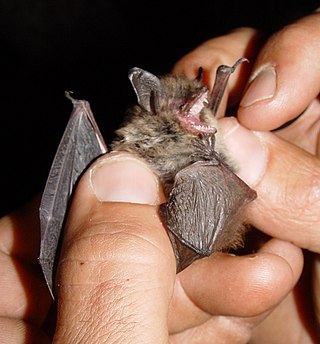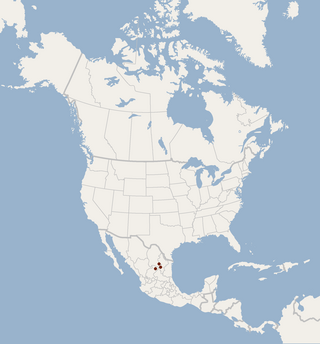
Natterer's bat is a European vespertilionid bat with pale wings. It has brown fur tending to greyish-white on its underside. It is found across most of the continent of Europe, parts of the Near East and North Africa. It feeds on insects and other invertebrates which it catches on the wing or pursues on the ground.

The mouse-eared bats or myotises are a diverse and widespread genus (Myotis) of bats within the family Vespertilionidae. The noun "myotis" itself is a Neo-Latin construction, from the Greek "muós and "oûs", literally translating to "mouse-eared".

The Alpine long-eared bat or mountain long-eared bat is a species of long-eared bat. It was originally described from Switzerland and Austria as a species intermediate between the brown long-eared bat and the grey long-eared bat in 1965. It was later described in 2002, from France and Austria, respectively. Despite its name, this species is not restricted to the Alps, being found in Croatia, Bosnia and Herzegovina and elsewhere. It differs from other European long-eared bats, such as the brown long-eared bat, by its white underparts.

Hodgson's bat, also called the copper-winged bat or black-and-orange myotis, is a species of vesper bat in the genus Myotis, the mouse-eared bats. Favouring mountain forests, it is found throughout Central, Southeast, and East Asia, from Afghanistan to Taiwan. It is about 5 centimetres (2.0 in) long and is distinguished from most other species of bat in this range by its yellowish colouration.

Brandt's bat or Brandt's myotis is a species of vesper bat in the family Vespertilionidae. It is native throughout most of Europe and parts of western Asia.

Geoffroy's bat, also known as the notch-eared bat, is a species of vesper bat.

The eastern small-footed bat is a species of vesper bat. It can be found in southern Ontario and Quebec in Canada and in mountainous portions of the eastern United States from New England to northern Georgia, and westward to northern Arkansas. It is among the smallest bats in eastern North America and is known for its small feet and black face-mask. Until recently, all North American small-footed Myotis were considered to be "Myotis leibii". The western population is now considered to be a separate species, Myotis ciliolabrum. The eastern small-footed bat is rare throughout its range, although the species may be locally abundant where suitable habitat exists. Studies suggest white-nose syndrome has caused declines in their populations. However, most occurrences of this species have only been counted within the past decade or two and are not revisited regularly, making their population status difficult to assess. Additionally, most bat populations in the eastern U.S. have been monitored using surveys conducted in caves and mines in the winter, but eastern small-footed bats hibernate in places that make them unlikely to be encountered during these surveys. Perhaps as a result, the numbers of eastern small-footed bats counted in winter tend to be low and they are relatively variable compared to other species of bats. Many biologists believe the species is stable, having declined little in recent times, but that it is vulnerable due to its relatively restricted geographic range and habitat needs.

The flat-headed myotis is a species of vesper bat. It is endemic to Mexico where it is found in certain montane forests in the Sierra Madre Oriental in the northeast of the country. Once thought to be extinct, this bat was rediscovered in 2004 by Joaquín Arroyo-Cabrales and colleagues. The species is now classified as endangered by the IUCN.

The frosted myotis is a species of vesper bat. It is found only in Japan.

Myotinae is a subfamily of vesper bats. It contains three genera: Eudiscopus, Myotis, and Submyotodon. Before the description of Submyotodon and analysis of its phylogenetics, as well as a phylogenetic analysis of Eudiscopus, the only member of Myotinae was Myotis.

The Alcathoe bat is a European bat in the genus Myotis. Known only from Greece and Hungary when it was first described in 2001, its known distribution has since expanded as far as Portugal, England, Sweden, and Russia. It is similar to the whiskered bat and other species and is difficult to distinguish from them. However, its brown fur is distinctive and it is clearly different in characters of its karyotype and DNA sequences. It is most closely related to Myotis hyrcanicus from Iran, but otherwise has no close relatives.

Escalera's bat is a European bat in the genus Myotis, found in Spain, Portugal, and far southern France.

Old Bow And Old Ham Mines is a 40.3-hectare (100-acre) biological Site of Special Scientific Interest in Gloucestershire, notified in 1998.

The cryptic myotis is a European vespertilionid bat. It is a member of the Natterer's bat species complex, and is also the closest living relative of M. nattereri.
Miniopterus maghrebensis, also known as the Maghrebian bent-wing bat, is a species of bat found in North Africa.

The Siberian bat or Siberian whiskered myotis is a species of vesper bat in the family Vespertilionidae. It is found throughout northeastern Asia, primarily in Siberia. It is known for its high life expectancy relative to its body size, approximately twice that of humans, and holds the record for the oldest bat; in 2005, one individual was discovered in a cave in Siberia that had been banded in 1964, making the bat at least 41 years old.














